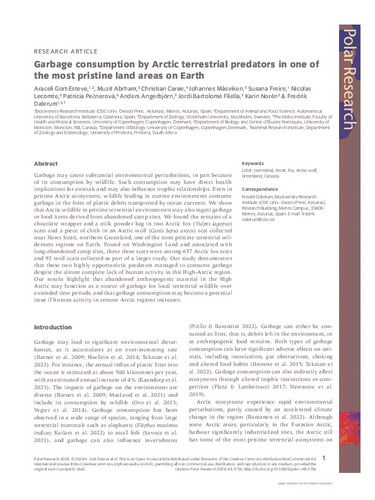Garbage consumption by arctic terrestrial predators in one of the most pristine land areas on earth
Publication date:
Publisher version:
Citación:
Abstract:
Garbage may cause substantial environmental perturbations, in part because of its consumption by wildlife. Such consumption may have direct health implications for animals and may also influence trophic relationships. Even in pristine Arctic ecosystems, wildlife feeding in marine environments consume garbage in the form of plastic debris transported by ocean currents. We show that Arctic wildlife in pristine terrestrial environments may also ingest garbage or food items derived from abandoned camp sites. We found the remains of a chocolate wrapper and a milk powder bag in two Arctic fox (Vulpes lagopus) scats and a piece of cloth in an Arctic wolf (Canis lupus arctos) scat collected near Nares Strait, northern Greenland, one of the most pristine terrestrial wil-derness regions on Earth. Found on Washington Land and associated with long-abandoned camp sites, these three scats were among 657 Arctic fox scats and 92 wolf scats collected as part of a larger study. Our study demonstrates that these two highly opportunistic predators managed to consume garbage despite the almost complete lack of human activity in this High-Arctic region. Our results highlight that abandoned anthropogenic material in the High Arctic may function as a source of garbage for local terrestrial wildlife over extended time periods, and that garbage consumption may become a potential issue if human activity in remote Arctic regions increases.
Garbage may cause substantial environmental perturbations, in part because of its consumption by wildlife. Such consumption may have direct health implications for animals and may also influence trophic relationships. Even in pristine Arctic ecosystems, wildlife feeding in marine environments consume garbage in the form of plastic debris transported by ocean currents. We show that Arctic wildlife in pristine terrestrial environments may also ingest garbage or food items derived from abandoned camp sites. We found the remains of a chocolate wrapper and a milk powder bag in two Arctic fox (Vulpes lagopus) scats and a piece of cloth in an Arctic wolf (Canis lupus arctos) scat collected near Nares Strait, northern Greenland, one of the most pristine terrestrial wil-derness regions on Earth. Found on Washington Land and associated with long-abandoned camp sites, these three scats were among 657 Arctic fox scats and 92 wolf scats collected as part of a larger study. Our study demonstrates that these two highly opportunistic predators managed to consume garbage despite the almost complete lack of human activity in this High-Arctic region. Our results highlight that abandoned anthropogenic material in the High Arctic may function as a source of garbage for local terrestrial wildlife over extended time periods, and that garbage consumption may become a potential issue if human activity in remote Arctic regions increases.
ISSN:
Patrocinado por:
Field data collection was logistically supported by the Swedish Polar Research Secretariat by offering participa- tion in the expeditions Petermann 2015 and Ryder 2019. Financial support was further provided by the Spanish Ministry of Economy and Competitiveness (RYC-2013- 14662), by the Spanish Ministry of Science and Innovation (PID2019-107862RB-I00) and by the Spanish National Research Council (LINKA20417)
Collections
- Artículos [37530]
- Biología de Organismos y Sistemas [761]
Files in this item





